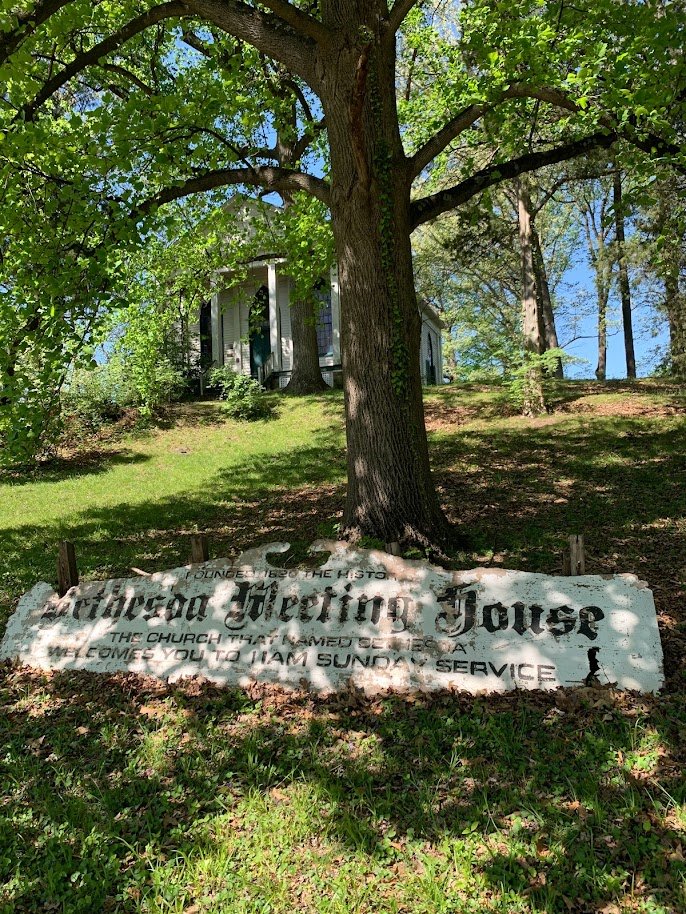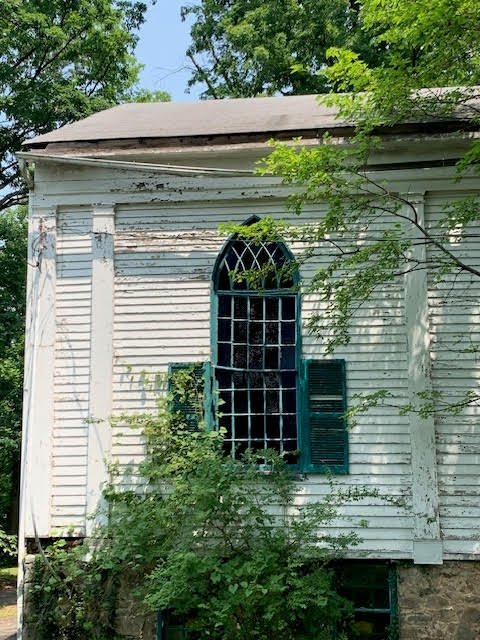Bethesda Meeting House
Help the Bethesda Historical Society Save the Bethesda Meeting House!
Local historical society purchases ‘the church that named Bethesda’

by Elia Griffin Updated
The Bethesda Meeting House, a historic church that is the namesake for the thriving urban center, was purchased by a local historic preservation group on Jan. 8. The group, the Bethesda Meeting House Foundation (BMHF), will oversee the future use and restoration of the church, which showed signs of deterioration in recent years.
BMHF is exploring options in partnering with a local nonprofit organization to use the site. According to Hank Levine, the president of BMHF, the meeting house is “by far the most important historic building near downtown Bethesda and literally embodies the history of the community.”
The church served as the town’s first post office in 1852 and was occupied by Confederate calvary during an 1864 Civil War “skirmish” in what is now downtown Bethesda, a press release stated. According to legend, the church’s bell is linked to Paul Revere and Abraham Lincoln is said to have worshipped or spoken on the site.
"Most important historic building in Bethesda" deteriorates as future remains uncertain


by Jenna Bloom on the MOCO360 news website (June 29, 2023)
Tucked away up a hill in North Bethesda sits a church building that is the namesake for the thriving urban center that surrounds it, built centuries ago and consistently in use–until recently.
The Bethesda Presbyterian Church built the Bethesda Meeting House in 1820 at what is now 9400 Rockville Pike and named it after a healing pool in Jerusalem. About 40 years later, the church’s pastor Rev. Edward Cumpston petitioned for the area to take the well-known name of the church. In 1871, it did, and Bethesda was named.
After Bethesda Presbyterian switched locations in 1925, Temple Hill Baptist Church took over the site. Its pastor Rev. Phillip Buford, who lived on and maintained the property, died in February 2022. The congregation has dwindled and no longer meets regularly since Buford’s death, according to the Bethesda Historical Society.
The building has since been passed over to a board of four trustees: the pastor’s wife Eloise Buford, his niece Sheri Nasca, her husband Edward Nasca, and David Moyer, the executive director of the Maryland Bible Society. Buford gave Sheri Nasca the authority to manage the property before his death; she lives in North Carolina. Attorney Thomas Schetelich has been designated to speak on behalf of the trustees.
The new owners don’t have a “realistic way right now to commit the amount of money it would take” to maintain the property, said Schetelich. Inspectors have issued notices for lack of compliance with codes and, because it is part of Montgomery County’s Historic Preservation Plan, there is legislation prohibiting its neglect.
Now the sign that once welcomed congregants to the “Church that named Bethesda” has fallen, and the building is in disrepair. Meanwhile, the Bethesda Historical Society is looking at options to preserve it.
“We’re interested in figuring out a way to save an important part of our culture and our history in the town,” Hank Levine, the Bethesda Meeting House project lead, said. Levine laid out several community-oriented possibilities for the property, including an office space for nonprofits or a meeting facility. “People can have concerts, we can have an art gallery, it can be used by a new or struggling congregation as a church,” Levine added.
Another option is for a local private school, such as Stone Ridge School of the Sacred Heart or Rochambeau French International School, to use it as a campus or remote space, but Levine says neither one has expressed interest. Renovations of this property will come with a hefty price tag, and the state is exploring options to provide assistance.
The most “legislator friendly” approach, according to State Delegate Marc Korman, is using the state capital budget to leverage some financial resources for the site. “A lot of Bethesda is changing,” Korman said, “so having something like this that can represent Bethesda as it’s been historically could be very powerful for the community.”
A historic acquisition would likely take a combination of state and private resources all dedicated to the site’s preservation; the restoration of this property will be a multi-year project. Levine said the process can’t begin without control of the property, and control won’t happen without the funds to acquire it.
“We are literally talking about the most important historic building in Bethesda, and it is literally sitting there falling apart,” Levine said. Until a final decision is made to historically acquire the property, it will continue to do so.
Help the Bethesda Historical Society Save the Bethesda Meeting House!
We bought the Bethesda Meeting House!

Bethesda Meeting House Bought by Local Historic Preservation Group
Bethesda, MD January 8, 2024–The Bethesda Historical Society today announced the purchase of the historic Bethesda Meeting House, “the church that named Bethesda.”
A new entity, the Bethesda Meeting House Foundation (BMHF), was formed to take ownership of the property and oversee the restoration and future use of the church and adjacent parsonage that occupy it.
The Meeting House and parsonage sit on a hill overlooking Rockville Pike just north of the National Institutes of Health campus. The first Meeting House on the site was built in 1820 by the Bethesda Presbyterian Church and named after a healing pool in Jerusalem. After fire destroyed the building in 1849, the present Meeting House was constructed, and the parsonage added.
Hank Levine, President of BMHF, noted that “the Meeting House is by far the most important historic building near downtown Bethesda and literally embodies the history of the community.” It served as the town’s first post office in 1852 and was occupied by Confederate cavalry during a July 1864 Civil War skirmish in what is now downtown Bethesda. According to legend, the Church’s bell is linked to Paul Revere and Abraham Lincoln is said to have worshipped or spoken there. The building is notable for its rare “slave gallery,” where enslaved persons were permitted to worship. The Meeting House and parsonage are listed in the National Register of Historic Places and were among the original sites on the 1979 Montgomery County Master Plan for Historic Preservation.
Wendy Kaufman, Secretary-Treasurer of BMHF, noted that “in 1871, the Church’s pastor persuaded a newly appointed local postmaster to petition the Post Office Department to rename the area Bethesda (it was then known as Darcy’s Store). The petition was granted, and the rest is – literally — history.”
The last congregation to occupy the Meeting House, Temple Hill Baptist Church, ceased worshipping there several years ago. The buildings have not been maintained, and extensive restoration work will be necessary. Leading members of the local real estate, legal, and historic preservation communities have volunteered their time and expertise to help BMHF complete the acquisition and plan the buildings’ restoration.
The Foundation is exploring the possibility of partnering with a local nonprofit organization to use the site. “It’s a community treasure,” added BMHF Vice President David Schardt, “and it deserves to be a civic asset.”